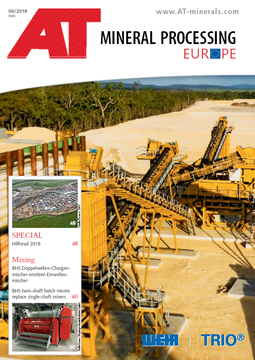Rubber – an expedient material in gravel extraction and processing
Crucial for the extraction of sand and gravel with suction dredgers has therefore been the availability of suitable materials for the making of the necessary pipelines. To this end, developers drew on experience with the conveying of highly abrasive suspensions, e.g. concrete. In the conveying lines from the dredger to the transfer point on land, rubber hoses were used from the very beginning, which guarantee the necessary mobility of the floating lines in the working area of the dredger. On the other hand, they make the lines less sensitive to wind pressure – a factor that is particularly important on the Lower Rhine and in the Netherlands because of frequently strong winds prevailing there.
Operational experience showed that rubber hoses mounted between the individual pipeline sections on pontoons often reach a longer service lifetime than the pipes made of steel and other materials connected to them. In steel pipes, for example, the suspended gravel slides along the bottom of the pipeline, the edges of the material chipping off bits of the pipes. In addition comes the impact stress caused by the turbulence of the flow, which leads to particles and stones hitting the wall of the pipeline and removing material.
In comparison with a steel surface, the inside surface of a rubber hose is soft and flexible. The impact of stones on the wall caused by turbulence is cushioned by the rubber. Sharp-edged particles don’t scrape over the surface but roll off it as the edges of the particles catch in the rubber surface. Accordingly, the specific material removal from the rubber hose is much less than from a steel or high-carbon steel pipe, leading to a considerable increase in service lifetime. Characteristic is also the smooth, often velvet-like surface that results from the wear mechanism in rubber components. It leads to a much lower flow resistance compared to steel pipes. In practice, that leads to around 30-%-lower power consumption of the delivery pumps or with the same pumping rate to an around 30-%-longer possible conveying distance.
On account of the excellent wear behaviour of rubber, the hoses were further developed to rubber pipes that combine the good wear properties of rubber with the mechanical properties of steel pipes. As a rule of thumb, the total delivery rate achievable with rubber pipes is around ten times that with steel pipes and around four times that of pipelines lined with high-carbon steel.
Another optimization of the transport route between suction dredger and land is achieved with the use of rubber hoses equipped with plastic floats. These special structures are currently the most cost-efficient solution for this transport application. In contrast to steel or rubber pipelines, no pontoons are necessary. Moreover, the conveying line lying in the water is not exposed to any lateral pressure caused by wind, and can’t be used as a pathway between land and dredger, making vandalism more difficult.
Other wear-critical points of wet gravel extraction are on the dredging vessel itself. At the delivery pump, as well as in the pressure pipe, a bend must be used to compensate for the change in direction of the flow in the pump. Traditionally. these bends were made of steel pipes with solid wall thicknesses or of segments of high-carbon steel or special chill-cast iron. At this point, the use of rubber leads to much improved cost efficiency. A special production process enables the rubber bends to be fitted precisely as the bend angle and radii can be freely selected over a wide range. So, for example, a bend NW 300 with a bend radius of 715 mm and a bend angle of 82 ° can be manufactured in the normal production process.
Another advantage of using rubber hoses and rubber pipes is the high sound-absorbing effect of the material. To test this, at a distance of 10 m, sound pressure measurements were performed on a several hundred-metres-long line for conveying gravel, which consisted of sections of rubber pipes and steel pipes. When conveying gravel, the steel pipe generated a sound level of 60 – 70 DBA, while the rubber pipeline did not measurably contribute to the increase in the noise level in the environment. With the bespoke manufacture of a feed line of rubber pipes to a bucket wheel in a gravel works, existing problems caused by noise emissions in a nearby residential district could be resolved simply and cheaply without the otherwise necessary extensive construction work.
//www.vg-gmbh.de" target="_blank" >www.vg-gmbh.de:www.vg-gmbh.de










